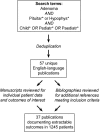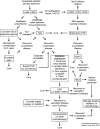Pediatric Pituitary Adenoma: Case Series, Review of the Literature, and a Skull Base Treatment Paradigm
- PMID: 29404245
- PMCID: PMC5796823
- DOI: 10.1055/s-0038-1625984
Pediatric Pituitary Adenoma: Case Series, Review of the Literature, and a Skull Base Treatment Paradigm
Abstract
Background Pediatric pituitary adenoma is a rare skull base neoplasm, accounting for 3% of all intracranial neoplasms in children and 5% of pituitary adenomas. Compared with pituitary tumors in adults, secreting tumors predominate and longer disease trajectories are expected due to the patient age resulting in a natural history and treatment paradigm that is complex and controversial. Objectives The aims of this study were to describe a large, single-institution series of pediatric pituitary adenomas with extensive long-term follow-up and to conduct a systematic review examining outcomes after pituitary adenoma surgery in the pediatric population. Methods The study cohort was compiled by searching institutional pathology and operative reports using diagnosis and site codes for pituitary and sellar pathology, from 1956 to 2016. Systematic review of the English language literature since 1970 was conducted using PubMed, MEDLINE, Embase, and Google Scholar. Results Thirty-nine surgically managed pediatric pituitary adenomas were identified, including 15 prolactinomas, 14 corticotrophs, 7 somatotrophs, and 4 non-secreting adenomas. All patients underwent transsphenoidal resection (TSR) as the initial surgical treatment. Surgical cure was achieved in 18 (46%); 21 experienced recurrent/persistent disease, with secondary treatments including repeat surgery in 10, radiation in 14, adjuvant pharmacotherapy in 11, and bilateral adrenalectomy in 3. At the last follow-up (median 87 months, range 3-581), nine remained with recurrent/persistent disease (23%). Thirty-seven publications reporting surgical series of pediatric pituitary adenomas were included, containing 1,284 patients. Adrenocorticotropic hormone (ACTH)-secreting tumors were most prevalent (43%), followed by prolactin (PRL)-secreting (37%), growth hormone (GH)-secreting (12%), and nonsecreting (7%). Surgical cure was reported in 65%. Complications included pituitary insufficiency (23%), permanent visual dysfunction (6%), chronic diabetes insipidus (DI) (3%), and postoperative cerebrospinal fluid (CSF) leak (4%). Mean follow-up was 63 months (range 0-240), with recurrent/persistent disease reported in 18% at the time of last follow-up. Conclusion Pediatric pituitary adenomas are diverse and challenging tumors with complexities far beyond those encountered in the management of routine adult pituitary disease, including nuanced decision-making, a technically demanding operative environment, high propensity for recurrence, and the potentially serious consequences of hypopituitarism with respect to fertility and growth potential in a pediatric population. Optimal treatment requires a high degree of individualization, and patients are most likely to benefit from consolidated, multidisciplinary care in highly experienced centers.
Keywords: hypopituitarism; pediatric pituitary adenoma; radiotherapy; stereotactic radiosurgery; transsphenoidal surgery.
Conflict of interest statement
Figures




References
-
- Espay A J, Azzarelli B, Williams L S, Bodensteiner J B. Recurrence in pituitary adenomas in childhood and adolescence. J Child Neurol. 2001;16(05):364–367. - PubMed
-
- Kane L A, Leinung M C, Scheithauer B W et al.Pituitary adenomas in childhood and adolescence. J Clin Endocrinol Metab. 1994;79(04):1135–1140. - PubMed
-
- Maira G, Anile C. Pituitary adenomas in childhood and adolescence. Can J Neurol Sci. 1990;17(01):83–87. - PubMed
-
- Mindermann T, Wilson C B.Pediatric pituitary adenomas Neurosurgery 19953602259–268., discussion 269 - PubMed
-
- Partington M D, Davis D H, Laws E R, Jr, Scheithauer B W. Pituitary adenomas in childhood and adolescence. Results of transsphenoidal surgery. J Neurosurg. 1994;80(02):209–216. - PubMed
Publication types
LinkOut - more resources
Full Text Sources
Other Literature Sources

